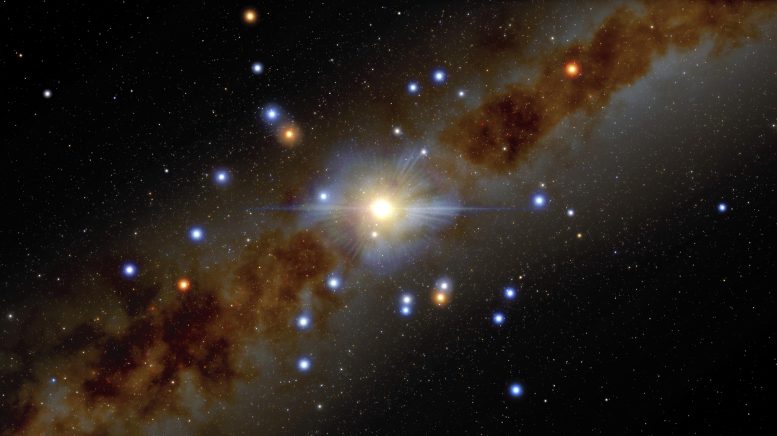
In this illustration, stars are seen to be in close orbit around the supermassive black hole that lurks at the center of the Milky Way, known as Sagittarius A* (Sgr A*). Credit: International Gemini Observatory/NOIRLab/NSF/AURA/J. da Silva/(Spaceengine), Acknowledgment: M. Zamani (NSF’s NOIRLab)
Precise Insights into the Supermassive Black Hole in the Milky Way’s Heart
Astronomers use Gemini Observatory and an international telescope collaboration to shed light on Sagittarius A*
Obtained with the help of the Gemini North telescope, astronomers have made the most precise measurements yet of the motions of stars around the supermassive black hole at the center of the Milky Way. These results show that 99.9% of the mass contained at the very center of the galaxy is due to the black hole, and only 0.1% could include stars, smaller black holes, interstellar dust, and gas, or dark matter.
Astronomers have measured more precisely than ever before the position and velocity of four stars in the immediate vicinity of Sagittarius A* (Sgr A*),[1] the supermassive black hole that lurks at the center of the Milky Way. The motions of these stars — called S2, S29, S38, and S55 — were found to follow paths that shows that the mass in the center of the Milky Way is almost entirely due to the Sgr A* black hole, leaving very little room for anything else.
The research team used a variety of cutting-edge astronomical facilities in this research. To measure the velocities of the stars, they used spectroscopy from the Gemini Near Infrared Spectrograph (GNIRS) at Gemini North near the summit of Maunakea in Hawai‘i, part of the international Gemini Observatory, a program of NSF’s NOIRLab, and the SINFONI instrument on the European Southern Observatory’s Very Large Telescope. The GRAVITY instrument at the VLTI was used to measure the positions of the stars.[2]
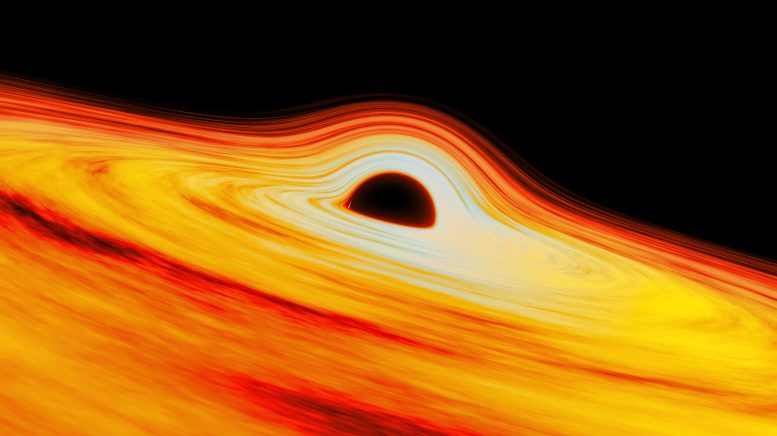
Illustration of the black hole Sagittarius A* at the center of the Milky Way. Credit: International Gemini Observatory/NOIRLab/NSF/AURA/J. da Silva/(Spaceengine), Acknowledgment: M. Zamani (NSF’s NOIRLab)
“We are very grateful to Gemini Observatory, whose GNIRS instrument gave us the critical information we needed,” said Reinhard Genzel, director of the Max Planck Institute for Extraterrestrial Physics and co-recipient of the 2020 Nobel Prize in physics. “This research shows worldwide collaboration at its best.”
The Galactic Center of the Milky Way, located roughly 27,000 light-years from the Sun, contains the compact radio source Sgr A* that astronomers have identified as a supermassive black hole 4.3 million times as massive as the Sun. Despite decades of painstaking observations — and the Nobel Prize awarded for discovering the identity of Sgr A*[3] — it has been difficult to conclusively prove that the majority of this mass belongs only to the supermassive black hole and does not also include a vast amount of matter such as stars, smaller black holes, interstellar dust and gas, or dark matter.
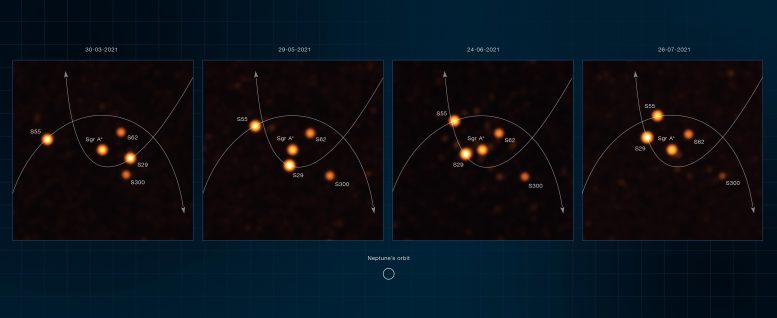
These annotated images, obtained with the GRAVITY instrument on ESO’s Very Large Telescope Interferometer (VLTI) between March and July 2021, show stars orbiting very close to Sagittarius A*, the supermassive black hole at the heart of the Milky Way. One of these stars, named S29, was observed as it was making its closest approach to the black hole at 13 billion kilometers, just 90 times the distance between the Sun and Earth. Another star, named S300, was detected for the first time in new VLTI observations reported by ESO.
Using Gemini North of the international Gemini Observatory, a Program of NSF’s NOIRLab and ESO’s VLT, astronomers have measured more precisely than ever before the position and velocity of these stars S29 and S55 (as well as stars S2 and S38), and found them to be moving in a way that shows that the mass in the center of the Milky Way is almost entirely due to the Sagittarius A* black hole, leaving very little room for anything else. Credit: ESO/GRAVITY collaboration
“With the 2020 Nobel prize in physics awarded for the confirmation that Sgr A* is indeed a black hole, we now want to go further. We would like to understand whether there is anything else hidden at the center of the Milky Way, and whether general relativity is indeed the correct theory of gravity in this extreme laboratory,” explained Stefan Gillessen, one of the astronomers involved in this work. “The most straightforward way to answer that question is to closely follow the orbits of stars passing close to Sgr A*.”
Einstein’s general theory of relativity predicts that the orbits of stars around a supermassive compact object are subtly different from those predicted by classical Newtonian physics. In particular, general relativity predicts that the orbits of the stars will trace out an elegant rosette shape — an effect known as Schwarzschild precession. To actually see stars tracing out this rosette, the team tracked the position and velocity of four stars in the immediate vicinity of Sgr A* — called S2, S29, S38, and S55. The team’s observations of the extent to which these stars precessed allowed them to infer the distribution of mass within Sgr A*. They discovered that any extended mass within the orbit of the S2 star contributes at most the equivalent of 0.1% of the mass of the supermassive black hole.
Animated sequence of ESO’s Very Large Telescope Interferometer (VLTI) images of stars around the Milky Way’s central black hole. This animation shows the orbits of the stars S29 and S55 as they move close to Sagittarius A* (center), the supermassive black hole at the heart of the Milky Way. As we follow the stars along in their orbits, we see real images of the region obtained with the GRAVITY instrument on the VLTI in March, May, June and July 2021. In addition to S29 and S55, the images also show two fainter stars, S62 and S300. S300 was detected for the first time in new VLTI observations reported by ESO.
Measuring the minute variations in the orbits of distant stars around our galaxy’s supermassive black hole is incredibly challenging. To make further discoveries, astronomers will have to push the boundaries not only of science but also of engineering. Upcoming extremely large telescopes (ELTs) such as the Giant Magellan Telescope and the Thirty Meter Telescope (both part of the US-ELT Program) will allow astronomers to measure even fainter stars with even greater precision.
“We will improve our sensitivity even further in future, allowing us to track even fainter objects,” concluded Gillessen. “We hope to detect more than we see now, giving us a unique and unambiguous way to measure the rotation of the black hole.”
Zooming into the heart of the Milky Way to see stars as observed by the European Southern Observatory’s Very Large Telescope (the last observation being from 2019). Zooming further in reveals stars even closer to the black hole, observed with the GRAVITY instrument on ESO’s Very Large Telescope Interferometry in mid-2021.
“The Gemini observatories continue to deliver new insight into the nature of our galaxy and the enormous black hole at its center,” said Martin Still, Gemini Program Officer at the National Science Foundation. “Further instrument development during the next decade intended for broad use will maintain NOIRLab’s leadership in the characterization of the Universe around us.”
For more on this research, see Watch Stars Race Around the Milky Way’s Supermassive Black Hole.
Notes
- Sagittarius A* is spoken as “Sagittarius A star.”
- ESO’s VLT is composed of four individual colocated 8.2-meter telescopes which can combine light through a network of mirrors and underground tunnels using a technique known as interferometry, to form the VLTI. GRAVITY uses this technique to measure the position of night-sky objects with high accuracy — equivalent to picking out a quarter-dollar coin on the surface of the Moon.
- The 2020 Nobel Prize in Physics was awarded in part to Reinhard Genzel and Andrea Ghez “for the discovery of a supermassive compact object at the center of our galaxy.”
This research is presented in the paper “The mass distribution in the Galactic Centre from interferometric astrometry of multiple stellar orbits” which is published in Astronomy & Astrophysics. A companion paper “Deep Images of the Galactic Center with GRAVITY” has also been published in Astronomy & Astrophysics.
References:
“Mass distribution in the Galactic Center based on interferometric astrometry of multiple stellar orbits” by GRAVITY Collaboration: R. Abuter, N. Aimar, A. Amorim, J. Ball, M. Bauböck, J. P. Berger, H. Bonnet, G. Bourdarot, W. Brandner, V. Cardoso, Y. Clénet, Y. Dallilar, R. Davies, P. T. de Zeeuw, J. Dexter, A. Drescher, F. Eisenhauer, N. M. Förster Schreiber, A. Foschi, P. Garcia, F. Gao, E. Gendron, R. Genzel, S. Gillessen, M. Habibi, X. Haubois, G. Heißel,??, T. Henning, S. Hippler, M. Horrobin, L. Jochum, L. Jocou, A. Kaufer, P. Kervella, S. Lacour, V. Lapeyrère, J.-B. Le Bouquin, P. Léna, D. Lutz, T. Ott, T. Paumard, K. Perraut, G. Perrin, O. Pfuhl, S. Rabien, J. Shangguan, T. Shimizu, S. Scheithauer, J. Stadler, A.W. Stephens, O. Straub, C. Straubmeier, E. Sturm, L. J. Tacconi, K. R. W. Tristram, F. Vincent, S. von Fellenberg, F. Widmann, E. Wieprecht, E. Wiezorrek, J. Woillez, S. Yazici and A. Young, 19 January 2022, Astronomy & Astrophysics.
DOI: 10.1051/0004-6361/202142465
“Deep images of the Galactic center with GRAVITY” by GRAVITY Collaboration: R. Abuter, N. Aimar, A. Amorim, P. Arras, M. Bauböck, J. P. Berger, H. Bonnet, W. Brandner, G. Bourdarot, V. Cardoso, Y. Clénet, R. Davies, P. T. de Zeeuw, J. Dexter, Y. Dallilar, A. Drescher, F. Eisenhauer, T. Enßlin, N. M. Förster Schreiber, P. Garcia, F. Gao, E. Gendron, R. Genzel, S. Gillessen, M. Habibi, X. Haubois, G. Heißel, T. Henning, S. Hippler, M. Horrobin, A. Jiménez-Rosales, L. Jochum, L. Jocou, A. Kaufer, P. Kervella, S. Lacour, V. Lapeyrère, J.-B. Le Bouquin, P. Léna, D. Lutz, F. Mang, M. Nowak, T. Ott, T. Paumard, K. Perraut, G. Perrin, O. Pfuhl, S. Rabien, J. Shangguan, T. Shimizu, S. Scheithauer, J. Stadler, O. Straub, C. Straubmeier, E. Sturm, L. J. Tacconi, K. R. W. Tristram, F. Vincent, S. von Fellenberg, I. Waisberg, F. Widmann, E. Wieprecht, E. Wiezorrek, J. Woillez, S. Yazici, A. Young and G. Zins, 19 January 2022, Astronomy & Astrophysics.
DOI: 10.1051/0004-6361/202142459
More information
The team behind this result is composed of The GRAVITY Collaboration, R. Abuter (European Southern Observatory), A. Amorim (Universidade de Lisboa and CENTRA – Centro de Astrofísica e Gravitação), M. Bauböck (Max Planck Institute for Extraterrestrial Physics and University of Illinois), J. P. Berger (University Grenoble Alpes and European Southern Observatory), H. Bonnet (European Southern Observatory), G. Bourdarot (University Grenoble Alpes and Max Planck Institute for Extraterrestrial Physics), V. Cardoso (CENTRA – Centro de Astrofísica e Gravitação and CERN), Y. Clénet (LESIA, Observatoire de Paris), Y. Dallilar (Max Planck Institute for Extraterrestrial Physics), R. Davies (Max Planck Institute for Extraterrestrial Physics), P. T. de Zeeuw (Leiden University and Max Planck Institute for Extraterrestrial Physics), J. Dexter (University of Colorado, Boulder), A. Drescher (Max Planck Institute for Extraterrestrial Physics), A. Eckart (University of Cologne and Max Planck Institute for Radio Astronomy), F. Eisenhauer (Max Planck Institute for Extraterrestrial Physics), N. M. Förster Schreiber (Max Planck Institute for Extraterrestrial Physics), P. Garcia (Universidade do Porto and CENTRA – Centro de Astrofísica e Gravitação), F. Gao (Universität Hamburg and Max Planck Institute for Extraterrestrial Physics), E. Gendron (LESIA, Observatoire de Paris), R. Genzel (Max Planck Institute for Extraterrestrial Physics and University of California, Berkeley), S. Gillessen (Max Planck Institute for Extraterrestrial Physics), M. Habibi (Max Planck Institute for Extraterrestrial Physics), X. Haubois (European Southern Observatory), G. Heißel (LESIA, Observatoire de Paris), T. Henning (Max Planck Institute for Astronomy), S. Hippler (Max Planck Institute for Astronomy), M. Horrobin (University of Cologne), L. Jochum (European Southern Observatory), L. Jocou (University Grenoble Alpes), A. Kaufer (European Southern Observatory), P. Kervella (LESIA, Observatoire de Paris), S. Lacour (LESIA, Observatoire de Paris), V. Lapeyrère (LESIA, Observatoire de Paris), J.-B. Le Bouquin (University Grenoble Alpes), P. Léna (LESIA, Observatoire de Paris), D. Lutz (Max Planck Institute for Extraterrestrial Physics), T. Ott (Max Planck Institute for Extraterrestrial Physics), T. Paumard (LESIA, Observatoire de Paris), K. Perraut (University Grenoble Alpes), G. Perrin (LESIA, Observatoire de Paris), O. Pfuhl (European Southern Observatory and Max Planck Institute for Extraterrestrial Physics), S. Rabien (Max Planck Institute for Extraterrestrial Physics), G. Rodríguez-Coira (LESIA, Observatoire de Paris), J. Shangguan (Max Planck Institute for Extraterrestrial Physics), T. Shimizu (Max Planck Institute for Extraterrestrial Physics), S. Scheithauer (Max Planck Institute for Astronomy), J. Stadler (Max Planck Institute for Extraterrestrial Physics), O. Straub (Max Planck Institute for Extraterrestrial Physics), C. Straubmeier (University of Cologne), E. Sturm (Max Planck Institute for Extraterrestrial Physics), L. J. Tacconi (Max Planck Institute for Extraterrestrial Physics), K. R. W. Tristram (European Southern Observatory), F. Vincent (LESIA, Observatoire de Paris), S. von Fellenberg (Max Planck Institute for Extraterrestrial Physics), F. Widmann (Max Planck Institute for Extraterrestrial Physics), E. Wieprecht (Max Planck Institute for Extraterrestrial Physics), E. Wiezorrek (Max Planck Institute for Extraterrestrial Physics), J. Woillez (European Southern Observatory), S. Yazici (Max Planck Institute for Extraterrestrial Physics and the University of Cologne), and A. Young (Max Planck Institute for Extraterrestrial Physics).

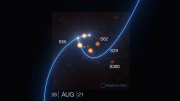


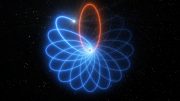


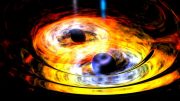

99.9% black hole. .1% other stuff.
Happy to be this far away.
Òf course the motion of star is determined by only gravity of super massive black hole.Effect of near by stars or cosmic effect on motion of star are commonly accounted.So on.
While everyone is focused on supermassive Black Holes at the centers of galaxies, another possibility exists. According to String Theory, a brane (dimensional membrane) surrounds our universe. What if such branes, rather than Black Holes, are also the centers of galaxies? Superheated gas would also form around branes, and they would explain how the matter in the universe became concentrated as galaxies even as the universe was, and still is, flying apart from the Big Bang at a rate that absolutely won’t allow any matter (quarks, even) to gravitationally attract each other to form anything. It would also explain those low-mass stars at the center of the Milky Way and the Andromeda galaxy, and other curious phenomena seen at those centers. How would we know if the center is a Black Hole or a brane? If material (gas, etc.) is seen swirling into the center, it’s a Black Hole. If material doesn’t swirl in, that would be support for a brane. The physical creation of brane-centered galaxies using the quantum foam and similar to Hawking radiation can be found by searching YouTube for “Creating Universes – A String Theory Way”
Great observation. Illuminating article. Love the Maths; LOVE that Einstein fellow. Maybe he’s in a Time/Space Space where he can see the FUTURE more clearly. I will await a complete report. But, in the meantime I will Speculate: Those “keeper” Star’s PETURBATIONS are representative of their struggle to stay alive; figuratively speaking. Indeed, they MAY BE next on the Menu.
It is all just awesome.
I live in Hawai’i. Maunakea is incorrect, proper spelling is Mauna Kea, the “White Mountain.” Just as Maunaloa is Mauna Loa, the “Long Mountain.”
Newton physics work only on earth the whole universe works definitely scientists should know already
Does anyone believe this crap 😅😅😅🤡
It’s a superdense singularity INSIDE of the Galactic black hole that is throwing all the math out of whack. Heed Einstein’s words.
so nothing new or different to report. thats kind of dull.